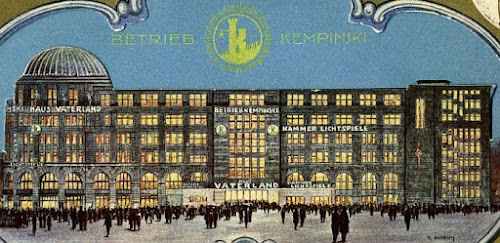 |
| Bundesarchiv, 102-13681/CC-BY-SA 3.0, CC BY-SA 3.0 de, //commons.wikimedia.org/w/index.php?curid=5481137 |
The Berlin establishment known as Haus Vaterland had little to do with patriotic feelings. Opened in 1928, it was a large
restaurant and entertainment palace with about one million visitors a year. It was situated by the Potsdamer Platz. The six-storey building looked as if built with massive stone but was in fact a steel skeleton construction with a stone facade.
Haus Vaterland (Fatherland's House) offered on top of all that a whole array of theme restaurants : Rhine Terrace, Bavarian beer hall, a Viennese Café and wine tavern, a turkish café, a spanish bodega, a hungarian tavern, a japanese tea room, a wild west bar, an osteria with Italian specialties, as well as a Palmensaal (Palm Hall), which was a dance hall, decorated with sculptures signed Josef Thorak (he was later to become one of the Third Reich’s official artists).
Note that there were no British or French sections as Kempinski, the owner, was too patriotic to forgive those countries for the Treaty of Versailles 1919, which many Germans judged unfair. Haus Vaterland was the flagship of that family of restaurant owners. Kempinski's patriotism didn't help him when Hitler came to power. He was forced to sell the establishment for an insignificant sum and leave the country.
 |
| The main entrance, on Köthener Strasse |
 |
| Side view from Köthener Strasse |
 | |||||
Besides food and drinks, there were also musical and artistic events. The weather simulations on the Rhine terrace were famous. Thunder and lightning were simulated every hour in a replica of the Rhine Valley landscape. Model trains drove around the valley, ship models sailed on the river and miniature airplanes (in cooperation with Lufthansa) zipped among the guests.
Just to add that, during the Iraq war 2003, a number of US restaurants stopped selling « french fries ». Instead, their menu offered «Freedom Fries ».
The writer Franz Hessel gave an ironic description of the establishment in his book "Walking in Berlin", 1929:
“Our tour-leader announces: “Café Vaterland, the largest café in the capital! ” We stare at the great ornate dome of the building, and those who have already experienced Berlin in the evening advise the others to visit this monster establishment with all its departments, its culinary ethnological museum and its panoramas in nocturnal light. Yes, they should do it. What use are our old palaces and museums? You are here to see mammoth Germany. So, just get in there tonight, gentlemen, into old Piccadilly, now House of Fatherland! Here are both patriotic and foreign things easily available. If the elevator has carried you up from the magnificent vestibule, you can comfortably look at the panorama from the Rhine terrace while enjoying the usual grape juice, where a first-class thunderstorm is shown over the vine hills, the river and the ruins. When the sky clears up again, Rhenish girls dance to you under vine hoops and velvet-jacketed scholars sing to them. You must have seen this. From there, please stumble into the bodega, where strange men with colorful bandages around your their head and stomach will bring you something fiery to transport you to a Spanish tavern. The two shy Spanish girls from Ackerstrasse (a street in East Berlin) in the corner will dance to raise your mood. Entering the Wild West Bar, according to the program, you will feel all the romance of the American prairie. By the way, don't forget to buy a program!" (my own translation)
And another writer, young Irmgard Keun, describes it like this in her novel "The artificial silk girl" from 1932:
"At Haus Vaterland there are terribly elegant stairs as in a castle with countesses walking - and landscapes and foreign lands and Turkish and Vienna and vine leaves and a colossal Rhine landscape with a real nature show in the form of thunder. We sit down, it gets so hot, it starts to get boring - the wine makes us feel like blown up - 'isn't it beautiful here and absolutely wonderful?' Because it is beautiful and wonderful, there is no other city that has something like this, with one room after another in a long row so that the whole thing feels like a real palace suite. Everybody is in such a hurry - often they seem so pale in the light here, the girls' clothes look like they haven’t been paid for and the men seem like they can’t really afford the wine they are drinking - maybe there is no one here who is happy?" (my own translation)









No comments:
Post a Comment